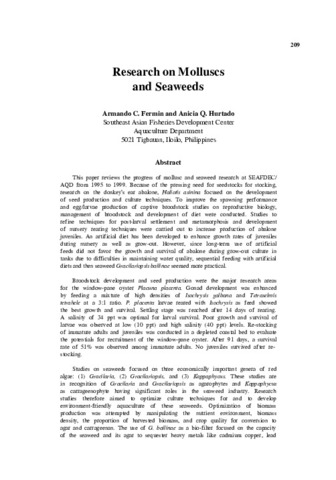Research on molluscs and seaweeds
| dc.contributor.author | Fermin, Armando C. | |
| dc.contributor.author | Hurtado, Anicia Q. | |
| dc.contributor.editor | Garcia, Luis Maria B. | |
| dc.date.accessioned | 2011-06-22T09:35:59Z | |
| dc.date.available | 2011-06-22T09:35:59Z | |
| dc.date.issued | 2001 | |
| dc.identifier.citation | Fermin, A. C., & Hurtado, A. Q. (2001). Research on molluscs and seaweeds. In L. M. B. Garcia (Ed.), Responsible Aquaculture Development in Southeast Asia. Proceedings of the Seminar-Workshop on Aquaculture Development in Southeast Asia organized by the Aquaculture Department, Southeast Asian Fisheries Development Center, 12-14 October 1999, Iloilo City, Philippines (pp. 209-219). Tigbauan, Iloilo, Philippines: Aquaculture Department, Southeast Asian Fisheries Development Center. | en |
| dc.identifier.isbn | 9718511474 | |
| dc.identifier.uri | http://hdl.handle.net/10862/473 | |
| dc.description.abstract | This paper reviews the progress of mollusc and seaweed research at SEAFDEC AQD from 1995 to 1999. Because of the pressing need for seedstocks for stocking, research on the donkey s ear abalone, Haliotis asinina focused on the development of seed production and culture techniques. To improve the spawning performance and egg/larvae production of captive broodstock studies on reproductive biology, management of broodstock and development of diet were conducted. Studies to refine techniques for post-larval settlement and metamorphosis and development nursery rearing techniques were carried out to increase production of abalone juveniles. An artificial diet has been developed to enhance growth rates of juveniles during nursery as well as grow-out. However, since long-term use of artificial feeds did not favor the growth and survival of abalone during grow-out culture in tanks due to difficulties in maintaining water quality, sequential feeding with artificial diets and then seaweed Gracilariopsis bailinae seemed more practical. Broodstock development and seed production were the major research areas for the window-pane oyster Placuna placenta. Gonad development was enhanced by feeding a mixture of high densities of Isochrysis galbana and Tetraselmis tetrahele at a 3:1 ratio. P. placenta larvae reared with Isochrysis as feed showed best growth and survival. Settling stage was reached after 14 days of rearing. A salinity of 34 ppt was optimal for larval survival. Poor growth and survival of larvae was observed at low (10 ppt) and high salinity (40 ppt) levels. Re-stocking immature adults and juveniles was conducted in a depleted coastal bed to evaluate potentials for recruitment of the window-pane oyster. After 91 days, a survival rate of 51% was observed among immature adults. No juveniles survived after re-stocking. Studies on seaweeds focused on three economically important genera of red algae: (1) Gracilaria, (2) Gracilariopsis, and (3) Kappaphycus. These studies are in recognition of Gracilaria and Gracilariopsis as agarophytes and Kappaphycus as carrageenophyte having significant roles in the seaweed industry. Research studies therefore aimed to optimize culture techniques for and to develop environment-friendly aquaculture of these seaweeds. Optimization of biomass production was attempted by manipulating the nutrient environment, biomass density, the proportion of harvested biomass, and crop quality for conversion to agar and carrageenan. The use of G. bailinae as a bio-filter focused on the capacity of the seaweed and its agar to sequester heavy metals like cadmium copper, lead and zinc after exposure to various concentrations of these metals. Likewise, excess levels of nitrogen and phosphorus in a finfish broodstock tank with re-circulating water were reduced, demonstrating the efficiency of the seaweed as a bio-filter in aquaculture. Eco-physiological studies of Gracilaria changii, G. coronopifolia, G. firma, and G. bailinae involved the mass production of spores-in vitro as a possible source of seedlings for outplanting. A socioeconomic survey of Kappaphycus culture in the Philippines revealed that, although expensive, deep-sea farming of K. alvarezii using the multiple raft long-line technique was more productive and profitable than the traditional mono-line or the popularly practiced hanging long-line technique. | en |
| dc.language.iso | en | en |
| dc.publisher | Aquaculture Department, Southeast Asian Fisheries Development Center | en |
| dc.subject | South East Asia | en |
| dc.subject | experimentation | en |
| dc.subject.lcc | VF SP 0278 | |
| dc.title | Research on molluscs and seaweeds | en |
| dc.type | Conference paper | en |
| dc.citation.spage | 209 | |
| dc.citation.epage | 219 | |
| dc.citation.conferenceTitle | Responsible Aquaculture Development in Southeast Asia. Proceedings of the Seminar-Workshop on Aquaculture Development in Southeast Asia organized by the SEAFDEC Aquaculture Department, 12-14 October 1999, Iloilo City, Philippines | en |
| dc.subject.asfa | aquaculture techniques | en |
| dc.subject.asfa | artificial feeding | en |
| dc.subject.asfa | diet | en |
| dc.subject.asfa | hatcheries | en |
| dc.subject.asfa | mollusc culture | en |
| dc.subject.asfa | rearing techniques | en |
| dc.subject.asfa | seaweed culture | en |
| dc.subject.asfa | seed production | en |
Files in this item
รายการนี้ปรากฏใน (s)
-
ADSEA '99 [21]
Proceedings of the Seminar-Workshop on Aquaculture Development in Southeast Asia


